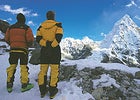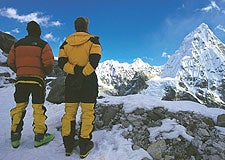“ONCE YOU MOVE AWAY from the 8,000-meter peaks, there are hardly any people going to Nepal,” says British alpinist Mick Fowler. “And it’s because they are feeling ripped off.”
 Climbers Willie Benegas and Cameron Lawson take in the summit of White Wave
Climbers Willie Benegas and Cameron Lawson take in the summit of White Wave
Not to mention flat-out scared. With an armed Maoist rebellion still simmering in an estimated third of the country, “People are now focusing on South America and Africa, areas not in the news,” laments Andy Crisconi, co-owner of the Colorado-based outfitter KE ���ϳԹ��� Travel, which specializes in Nepal trips. Of course, Nepal has never been a bargain for climbers. Fowler calls the kingdom—where payoffs and kickbacks are a fact of life—the most expensive nation in the Himalayas, not counting Bhutan. As tourist numbers plunged this past winter, it became clear that the greatest mountain playground on earth had landed on the rocks.
But with luck, and a little more openness from Nepal’s Ministry of Tourism, it might not stay there for long. In December, well into the planning cycle for the premonsoon adventure season that kicked off in March, the ministry said it would begin issuing climbing permits for 103 new peaks above 5,000 meters, including White Wave—a spectacular 5,809-meter pyramid—and Nangpa Gossum, on the Tibet border (at 7,350 meters, it is the highest on the list). The ministry also invited backpackers to six never-before-opened trekking areas, including the Walungchung Gola, a region in the northeast offering hundreds of lakes and sweeping views of Kanchenjunga. All together, the terrain amounts to thousands of square miles of largely untouched mountains and valleys—an unprecedented offering from a country that only began welcoming organized tour groups in 1955.
So far, everybody seems thrilled. Mountain Travel Sobek, the El Cerrito, California-based adventure outfitter, hopes to offer trips to the new trekking areas as early as this fall. And alpinists are, well, stoked. “A lot of the peaks on this new list I would imagine are pretty spectacular,” says Fowler, a 45-year-old climber from Melbourne, England, who last year secured special permission and a Polartec Challenge grant to attempt Peak 43, one of the newly opened mountains. “They would attract a lot of people like me.”
And not a moment too soon. The year 2001 proved to be one of the bleakest for Nepal in recent decades. Though strikes paralyzed the capital in January, things really began to head south in April, when Maoist rebels killed 31 police officers in the first of several such shootouts to come. In June, Crown Prince Dipendra went on a drunken rampage and shot dead nine members of the royal family, including King Birendra, before turning the gun on himself. The Nepalese government only made matters worse. Despite the fact that not a single foreigner has been either the target or the victim of Maoist violence in the rebellion’s six-year history, Nepal branded the revolutionaries “terrorists”—hardly a brochure-friendly term in the months following September 11—and declared a nationwide state of emergency. The U.S. State Department advised citizens to defer travel to the kingdom, and visits by Americans plunged 62 percent in December, compared with the same period the previous year. Last fall, not a single team attempted Everest.
A tourism crisis of this magnitude won’t reverse itself overnight. Most of the ten Kathmandu-based trekking agencies surveyed for this article said their spring bookings were down more than 50 percent. Similarly, Danbury, Connecticut, outfitter Himalayan Travel reports a 25 percent decline in confirmations. Mountain Travel Sobek canceled two scheduled Nepal trips for lack of interest, and KE ���ϳԹ��� Travel nixed seven. On the other hand, things are more or less back to normal at Everest; numerous expeditions are scheduled for April and May.
Though Maoists continued to skirmish with the military in remote areas of the country, by midwinter the army appeared to have them on the run, and on January 24, the U.S. State Department downgraded its travel warning. “This ’emergency’ is psychological,” says Ravi Chandra Hamal, CEO of the Ama Dablam ���ϳԹ��� Group, a tour operator headquartered in Kathmandu. “Things are more stable now than they were four months ago.” Indeed, after calling a friend in Nepal’s capital for an on-the-ground update, Wyoming climber Dave Anderson, 37, went ahead with a December trip to 6,185-meter Kwangde Lho. “It was much less a state of emergency than I thought,” he says.
In the meantime, the list of new peaks is making the rounds of the world’s alpine clubs, and outfitters hope new trips into untracked valleys will prove irresistible to trekkers come fall. Even more incentives are in the works: Nepalese government sources say they are working on new regulations that would effectively eliminate the May 31 season deadline Everest climbers face when trying to time a summit bid. “Nepal is starting to get the message that they need to be more service-oriented and more proactive to tourism,” says Pete Athans, who has been to the top of the world six times.
Like many adventurers, Athans believes Nepal’s new terrain will encourage more shoestring travelers to explore some of the globe’s last remaining unclimbed areas. He’s already updated his own tick list. “I would like to go out and do the Yak’s Horn,” he says, referring to newly opened 6,948-meter Mount Tengi Ragi Tau, close to Cho Oyu. “It’s a beautiful peak,” he says. “And I’m pretty sure there won’t be any Maoists out there.”


